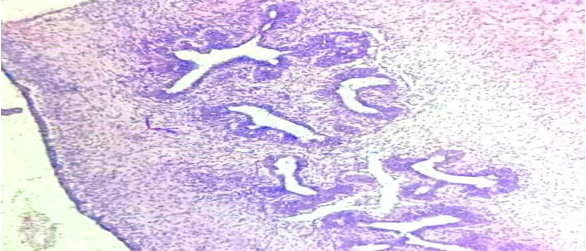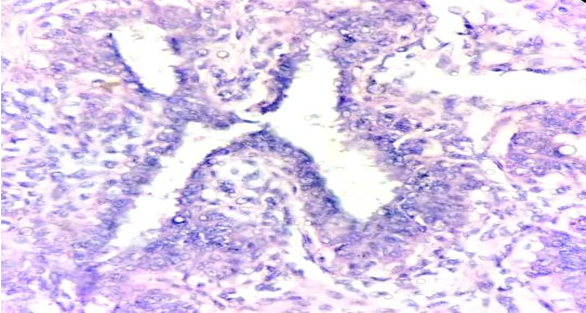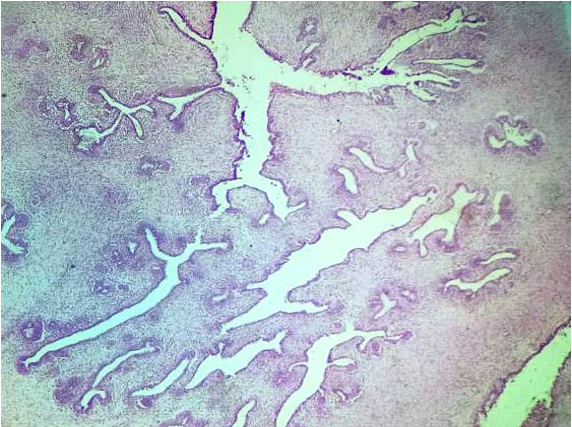Introduction
Benign breast diseases are heterogeneous group of lesions with diverse symptoms and or detected by incidental microscopic findings.1
30% of the women suffer from benign breast diseases and require treatment.2
The lesions are common in younger population, the incidence rises during the second decade and peak in the fourth and fifth decades. The malignant diseases are more common in the post-menopausal women.2, 3, 4, 5, 6, 7 These lesions maybe asymptomatic or have visible clinical manifestations such as palpable lump, pain in lump, mastalgia and nipple discharge. These non-specific symptoms are also encountered in various breast diseases, hence further evaluation by imaging techniques (USG & Mammogram) and histopathological study (core biopsy) for definitive diagnosis is mandatory. Love s et al 8 classified (NASHVILLE CLASSIFICATION) benign breast diseases into the non-proliferative lesions, proliferative lesions without atypia, proliferative lesions with atypia. Proliferative breast diseases are proliferation of epithelial cells without atypia are associated with a small increase in the risk of subsequent carcinoma in the breast. 1 These are predictors of risk but are thought to be unlikely precursors of carcinoma. 1, 2, 9, 3, 4, 6, 7, 10, 11 Benign breast diseases are very common but complex process hence requires integrative approach involving the clinician, radiologist and pathologist. 2
Materials and Methods
The prospective study was conducted in the Department Of Pathology, Santhiram Medical College and Hospital, Nandyal, Kurnool for a period of 2 years, i.e from December 2018 to November 2020. All the female patients of the breast disease irrespective of the age admitted/ attended in the Santhiram Hospital from in and around Nandyal were selected for the study. Relevant clinical data obtained from the hospital records.
Institutional ethical committee clearance was taken for the study. A total of 140 female patients with clinical and radiological diagnosis of benign breast diseases were included in the study.
Exclusion criteria
Women with malignant diseases.
Patients on radiotherapy and chemotherapy.
Lactating women and women with breast abscess were excluded from the study.
After the clinical diagnosis, the patients were subjected for radiological investigations likes USG, Mammogram & MRI.
FNAC followed by Tru-Cut biopsy and excision biopsy. The excised tissue was fixed in 10% Formalin & routine processing was done. The H&E stained sections examined under light microscope. Histopathological diagnosis was correlated with clinical, radiological and cytological findings.
Results
In the present study, 140 cases were evaluated.
Majority of Benign breast diseases were highest in the age group of 21-30 years (86 cases, 61.4%). Least common affected in the age group of below 20yrs (2 cases, 1.4%) and more than 50 years (1 cases, 0.7%).
The most common presentation was lump in the breast (116 cases, 82.7%), Painless lump (90 cases 64.2%), with Pain (26 cases,18.5%), nodularity (14cases, 10%) and nipple discharge (10 cases, 7.1%) were the other presenting complaints. More than one symptom was present in the same patient. Pain in both breast was noted in more than 50 cases. The pain was cyclical in 20 cases and non-cyclical in 10 cases. Only one case (1.3%) presented with nipple discharge with palpable lump & pain in breast.
Site
The and right breast in 74cases (52.8%) patients and the left breast affected in 60 cases (42.2%) patients. In 6cases (4.2%) patients both the breasts were affected. Majority of the breast lumps were located in upper outer quadrant 100 cases (71.4%), followed by lower inner quadrant 30 cases (21.4%) and least in upper inner quadrant 10 cases (7.1%).
Size
Minimum size of the breast lump was 1-2 cms and maximum size being 10cms. Majority of the breast lump were with the size range from 3-5cms (50cases; 35.6.8%) followed by 2-3cms (40cases; 28.5%). Fibroadenoma in the size range of 2-3cm [40 cases 28.5%]. More than 5cms size was mostly noted in phyllodes tumour and proliferative breast disease with and without atypia lesions (22 cases; 15.7%) Fibroadenoma (76; 54.2%) was the most common lesion followed by Fibroadenosis (25; 17.8%), proliferative breast disease with atypia (8; 5.7%), without atypia (16; 11.4%) and benign phyllodes tumour (14; 10%).
Table 1
Clinical features
|
Clinical features |
Number |
% |
|
Breast Lump Painless |
90 |
64.2% |
|
Breast Lump Asco Pain |
26 |
18.5% |
|
Nipple Discharge] |
10 |
7.1% |
|
Nodularity |
14 |
10% |
Table 2
Site distribution
|
Location |
Number |
% |
|
Upper Inner Quadrant |
10 |
7.1% |
|
Upper Outer Quadrant |
100 |
71.4 % |
|
Lower Inner Quadrant |
30 |
21.4% |
Table 3
Size distribution
|
Size |
Number |
% |
|
1 – 2 cms |
28 |
20% |
|
2 – 3 cms |
40 |
28.5% |
|
3 - 4 cms |
25 |
17.8% |
|
4 - 5 cms |
25 |
17.8% |
|
5 & > 5 cms |
22 |
15.7% |
Table 4
Latrality of the lesions
Table 5
Age wise distribution
Discussion
Physiological changes in the breast are hormonal dependant. They are maturation, cyclical & reproductive changes and involution of breast. The exaggerated physiological changes results as a disorder.12 The presentation of benign breast disorders are variable as breast lump; lump with or without pain, nodule, axillary swelling, unilateral or bilateral breast pain, nipple discharge.
In this study the common presenting symptom was breast lump 116 cases (82.8%). Foncroft LM et al 2001 (87.4%), 13 Ratana chaikamont T et al 2005 14 (72.3%), Sangma et al 2013 15 (87%) documented that the breast lump was the most the commonest presentation, Our study correlated with the above authors.
And dint correlate with Trupti P Tonape et al 2018(58%)12 Satyajit Samal 2019 et al (53%), 2 Ilaiah M et al 201516 (58.3%), Chalya PL et al 201617 (67.6%)
Mastalgia (26cases; 18.5%) and nodularity (14 cases; 10%) was noted in 26+14=40 cases (28.5%). 30% by Koorapati Ramesh et al 2017 1 and 27.7% of cases by Satyajit Samal et al 2019.2 Hence our study correlated.
The incidence of mastalgia was 26cases (18.5%) in the present study was equal with Sangma et al 2013 15 who reported 33% cases., 12.8% to 30.3% range by La Vecchia C et al 1985. 7
The incidence of nipple discharge was 9% La Vecchia C et al 1985,18 8% by Sangma et al 2013, 8% by Koorapati Ramesh et al 2017. 1 Our study showed 14 cases (10%) and correlated with the above authors.
In the present study 52.8% (74/140) cases had right breast lesion, 42.8% (60/140) had left breast and 6 cases (4.2%) had both breast lesions. Koorapati Ramesh et al 2017. 1 had 52%, 32% and 16%. Chalya PL et al 2016 17 had 53.8%, 42.8% and 3.4%,. Sangma et al 2013 15 48%, 40%, 12% and Shambhu Kumar Singh et al 2016 19 54.8%, 45.16% Our study correlated with the above author’s study.
Trupti P Tonape et al 201812 reported 44% (50 cases) in left breast and 40% in right breast. 42.8% (60/140 cases) in the present study and differed with Trupti P Tonape et al 2018. 12
Sangma et al 201315 and Koorapati Ramesh et al 2017 1 reported 12% & 16% cases with bilateral breast involvement respectively. The present study showed (4.2%) 6/140, hence differed with above author’s studies.
Majority of the breast lumps 100 cases (71.4%), were located in upper outer quadrant followed by lower inner quadrant 30 cases (21.4%) and least in upper inner quadrant 10 cases (7.1%). Our study correlated with Koorapati Ramesh et al 2017.1 [60%,8%], Chalya PL et al 201617 [63.8%, 6.8%]. Trupti P Tonape et al 201812 documented that upper inner quadrant (30%) followed by upper outer quadrant (24%). Our study differed with Trupti P Tonape et al 2018.12
In the present study, the commonest age group was 20-30 years (86; 61.4%), and second common age group being 30-40 years (43; 30.7%) correlated with, Koorapati Ramesh 2017.1 (60%), Ilaiah M et al 201516 (58.3%) Trupti P Tonape et al 2018 12 (26%) Satyajit Samal et al 20192 (22%) & S David Nathanson et al 2014.20
In the present study, the youngest patient was 16 years of age, the oldest being 50 years. Similar observation made by Satyajit Samal et al 20192 and Koorapati Ramesh et al 2017.1 In the present study, least commonly affected age group was above age 50 years (1 case 0.7%).Our study correlated Trupti P Tonape et al 201812 (2%) differed with Koorapati Ramesh et al 20171 (4%) and Sangma et al 201315 (4%).
In the present study, fibroadenoma was the most common benign breast lesion (76/140 cases 54.2%) (in the age range of 20-30 years). Similar observation made by Navneet Kaur et al 2012.21 Koorapati Ramesh et al 2017 1 Observed 56.8% (142/250). Our study corelated with Sangma et al 2013 16 (48%), Koorapati Ramesh et al 2017.1 (56.8%), Trupti P Tonape et al 201812 (42%),46.6 & 55.6% by Adesunkami AR et al 2001,22 Ihekwaba FN et al 199423 and Greenberg R et al 1998. 24
The second common lesion was Fibroadenosis in 3rd and 4th decade 25/140 cases(17.8%).Similar observations made by Ihekwaba FN et al 199423 (19.7%), Sangma et al 201316 (18%) Florica JV et al 1994.25 Our study correlates with the above authors study.
Dupont WD et al 198526 identified proliferative breast diseases with atypia as 4.%, 4.6% by Sangma et al 2013.16 In the present study 8 cases; 5.7% observed, our study correlated with the above authors study and differed with Chalya PL et al 2016 17 (2%). There is 4 fold increase risk in proliferative breast diseases with atypia.16 Currently there is controversy over the classification of proliferative breast lesions and the microscopic risk assessment, causing less relevance in clinical practice.16 Hence there is need for new-morphological marker-genetic and molecular.
Conclusion
Benign breast disease is a common problem in women among 21-30 years. The common clinical presentations is painless mobile breast lump. Care should be taken to differentiate it as benign and or with malignant differentiation through clinical, radiological and histopathological assessment. There is no consensus on morphological risk factors, hence there is need for molecular and genetic study, which help in early detection of risk of malignancy and better clinical management.



